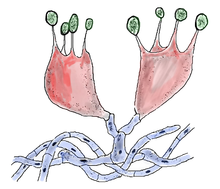Basidiospore
Basidiospores [from * basidio -, Greek spora = seed] are meiospores of the mushrooms ( Basidiomycota ), which arise on special outgrowths, the sterigms of the basidia . The germination takes place with budding cells , secondary spores Konidiosporen or germ hyphen .
Basidiospores
A basidiospore is a reproductive spore produced by mushrooms. Basidiospores grow on basidia and have a haploid core that is the product of meiosis . Typically, basidiospores grow on outer parts of the basidia. There are millions of basidia on the lamellae of a typical mushroom. Some types of fungus can produce up to billions of spores. But some even more, like the giant bovist , who produces around five billion basidiospores. Most basidiospores are actively released and are therefore considered ballistospores. These spores serve as reproductive units for the mushrooms. The spores are often released during periods of high humidity and generally have a night or pre-dawn peak concentration in the atmosphere.
When basidiospores encounter a favorable substrate, they can typically germinate through the formation of hyphae. These hyphae grow outward from the spore and form a mycelium that expands in a circle . The circular shape of a fungal colony explains the formation of witch rings, and also the circular lesions of skin-infecting fungi that can cause ringworm . Some basidiospores repeatedly germinate by forming small conidiospores instead of hyphae.
General structure and appearance
Basidiospores are located on the hilum , usually on the underside of the apiculus , i.e. on the side of the sterigma. Therefore, most of the basidiospores are asymmetrical. The exception to this is the belly mushrooms , since the basidiospores are not actively released, they have no apiculus and are therefore mostly symmetrical. In some basidiospores the hilum is quite pronounced, in others it is less noticeable. Basidiospores are mostly unicellular and extend from spherical, oval to elongated or also to ellipsoid and cylinder . The surface of the spore can be smooth, but also lightly to very heavily ornamented .
Web links
supporting documents
The Mycota VII- Systematics and Evolution, Part A (2nd ed.) - McLaughlin, Spataforta (Eds) - 2014 - Springer-Verlag Berlin Heidelberg.
- ↑ De-Wei Li. 2011 - Five trillion basidiospores in a fruiting body of Calvatia gigantea . Mycosphere 2 (4), 457-462. PDF file, accessed April 11, 2017
- ^ Sarah C. Watkinson, Lynne Boddy, Nicholas Money: The Fungi. Academic Press 2015, p. 86. ISBN 9780123820358 (preview on Google Books)
- ↑ Hans Halbwachs and Claus Bässler: Gone with the wind - a review on basidiospores of lamellate agarics. Mycosphere 6 (1), 2015, pp. 78–112 doi: 10.5943 / mycosphere / 6/1/10
